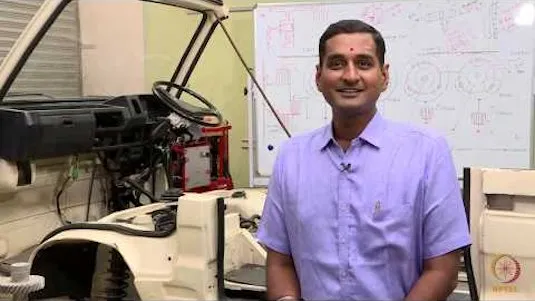
Ergonomics In Automotive Design 
This course provides an introduction to Ergonomics/ Human Factors Engineering in Automotive Design, helping students and teachers involved in Automobile Design and Engineering to understand the physical, cognitive and environmental aspects of vehicle components and occupants. It is beneficial for engineers and designers engaged in automotive sectors. ▼
ADVERTISEMENT
Course Feature
![]() Cost:
Cost:
Free
![]() Provider:
Provider:
Swayam
![]() Certificate:
Certificate:
Paid Certification
![]() Language:
Language:
English
![]() Start Date:
Start Date:
29th Jul, 2019
Course Overview
❗The content presented here is sourced directly from Swayam platform. For comprehensive course details, including enrollment information, simply click on the 'Go to class' link on our website.
Updated in [March 20th, 2023]
Knowledge of 'Ergonomics/ Human Factors Engineering' is of utmost necessity for automotive design and engineering to achieve optimal compatibility between occupants and vehicle components in terms of physical, cognitive and environmental aspects. Although good number of Design and Engineering Schools in India are offering courses on Automobile Design, Transportation Design and Automobile Engineering but there are less focus on Automotive Ergonomics due to lack of resources and trained faculty members. The current elective would not only help the students and teachers involved in Automobile Design and Engineering to overcome the aforesaid limitations but also would be beneficial for the engineers and designers engaged in automotive sectors.
INTENDED AUDIENCE
: UG and PG students of Industrial Engineering
PREREQUISITES:
Basic understanding of 'Applied Ergonomics'
INDUSTRY SUPPORT:
Industries associated with Automotive Design and Engineering
(Please note that we obtained the following content based on information that users may want to know, such as skills, applicable scenarios, future development, etc., combined with AI tools, and have been manually reviewed)
Learners can learn about the importance of ergonomics in automotive design and engineering, and how it can help to achieve optimal compatibility between occupants and vehicle components. They can gain knowledge of the principles of ergonomics and human factors engineering, and how they can be applied to automotive design and engineering. They can also learn about the various tools and techniques used in automotive ergonomics, such as anthropometry, biomechanics, and ergonomic design principles. Additionally, learners can gain an understanding of the industry support for automotive ergonomics, and the prerequisites for taking an automotive ergonomics course. Finally, learners can gain insight into the current elective courses available in India for automotive ergonomics, and how they can benefit students and teachers involved in automotive design and engineering.
[Applications]
The application of this course, Ergonomics in Automotive Design, can be seen in the automotive industry. It can help automotive engineers and designers to better understand the physical, cognitive, and environmental aspects of automotive design and engineering. This course can also help automotive design and engineering schools to better equip their students and faculty with the necessary knowledge and resources to understand ergonomics. Furthermore, this course can help automotive industries to better understand the importance of ergonomics in automotive design and engineering.
[Career Paths]
1. Automotive Ergonomics Engineer: Automotive Ergonomics Engineers are responsible for designing and developing vehicles that are comfortable and safe for the occupants. They use their knowledge of ergonomics to ensure that the vehicle components are compatible with the physical, cognitive, and environmental needs of the occupants. This job is expected to grow in the coming years as the demand for safer and more comfortable vehicles increases.
2. Automotive Design Engineer: Automotive Design Engineers are responsible for designing and developing the exterior and interior of vehicles. They use their knowledge of ergonomics to ensure that the design of the vehicle is comfortable and safe for the occupants. This job is expected to grow in the coming years as the demand for more aesthetically pleasing and ergonomically designed vehicles increases.
3. Automotive Safety Engineer: Automotive Safety Engineers are responsible for ensuring that vehicles meet safety standards. They use their knowledge of ergonomics to ensure that the vehicle components are compatible with the physical, cognitive, and environmental needs of the occupants. This job is expected to grow in the coming years as the demand for safer vehicles increases.
4. Automotive Research Engineer: Automotive Research Engineers are responsible for researching and developing new technologies for vehicles. They use their knowledge of ergonomics to ensure that the new technologies are compatible with the physical, cognitive, and environmental needs of the occupants. This job is expected to grow in the coming years as the demand for more efficient and safer vehicles increases.
[Education Paths]
1. Bachelor of Science in Automotive Engineering: This degree program focuses on the design, development, and production of automobiles and other motor vehicles. Students learn about the principles of engineering, automotive systems, and vehicle design. They also gain hands-on experience with the latest automotive technologies. This degree is becoming increasingly popular as the automotive industry continues to grow and evolve.
2. Master of Science in Automotive Ergonomics: This degree program focuses on the study of how people interact with vehicles and how to design vehicles to be more comfortable and safe for drivers and passengers. Students learn about the principles of ergonomics, human factors engineering, and vehicle design. They also gain hands-on experience with the latest automotive technologies. This degree is becoming increasingly popular as the automotive industry continues to grow and evolve.
3. Doctor of Philosophy in Automotive Ergonomics: This degree program focuses on the study of how people interact with vehicles and how to design vehicles to be more comfortable and safe for drivers and passengers. Students learn about the principles of ergonomics, human factors engineering, and vehicle design. They also gain hands-on experience with the latest automotive technologies. This degree is becoming increasingly popular as the automotive industry continues to grow and evolve.
4. Master of Science in Automotive Design: This degree program focuses on the design, development, and production of automobiles and other motor vehicles. Students learn about the principles of engineering, automotive systems, and vehicle design. They also gain hands-on experience with the latest automotive technologies. This degree is becoming increasingly popular as the automotive industry continues to grow and evolve.
Course Provider

Provider Swayam's Stats at AZClass
Discussion and Reviews
0.0 (Based on 0 reviews)
Explore Similar Online Courses

Conflict Management

AutoCAD: Advanced Dynamic Blocks

Python for Informatics: Exploring Information

Social Network Analysis

Introduction to Systematic Review and Meta-Analysis

The Analytics Edge

DCO042 - Python For Informatics

Causal Diagrams: Draw Your Assumptions Before Your Conclusions

Whole genome sequencing of bacterial genomes - tools and applications

Fundamentals of Automotive Systems

Every Dashboard Warning Lights in Your Car Explained Part - 1

How to Replace a VTC Actuator (Complete DIY Guide)
 Related Categories
Related Categories
 Popular Providers
Popular Providers
Quiz
 Submitted Sucessfully
Submitted Sucessfully
1. What is the intended audience for the course?
2. What is the main focus of the course?
3. What is the prerequisite for the course?
4. Which of the following is a prerequisite for this course?
5. What is the intended audience of the course?
Correct Answer: UG and PG students of Industrial Engineering


Start your review of Ergonomics In Automotive Design